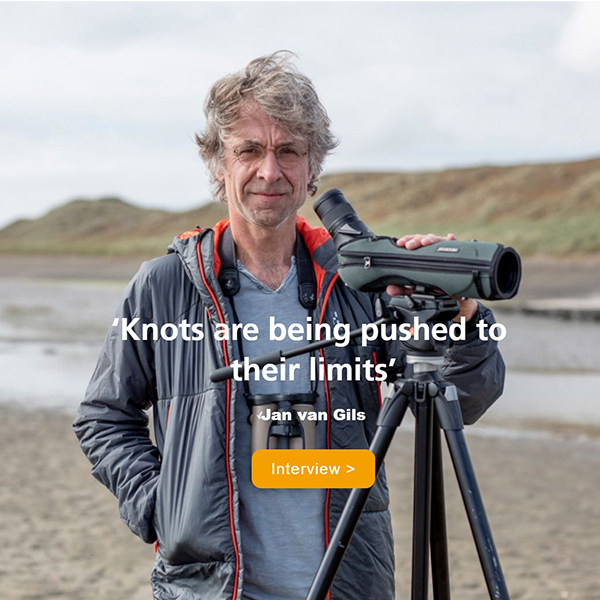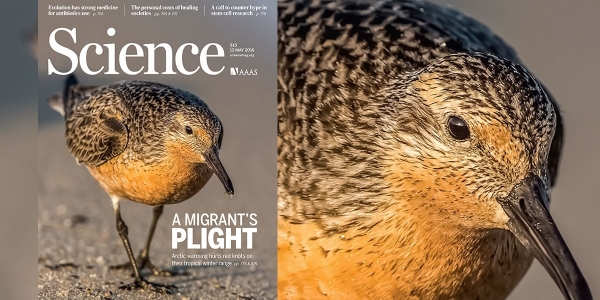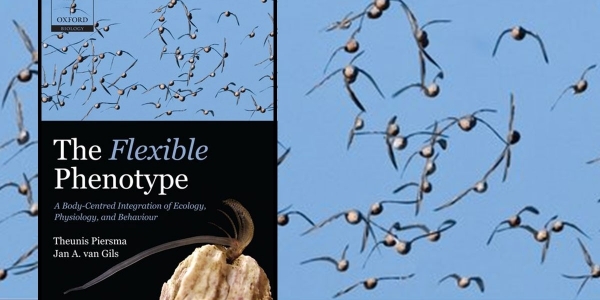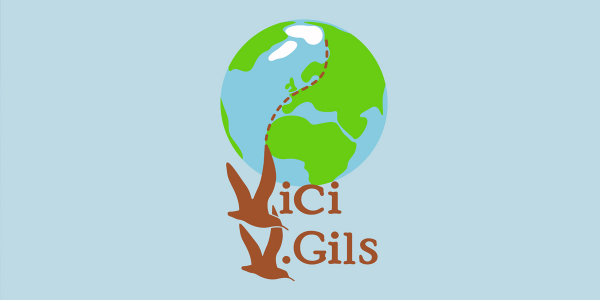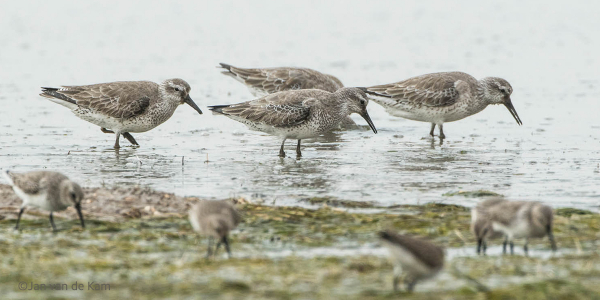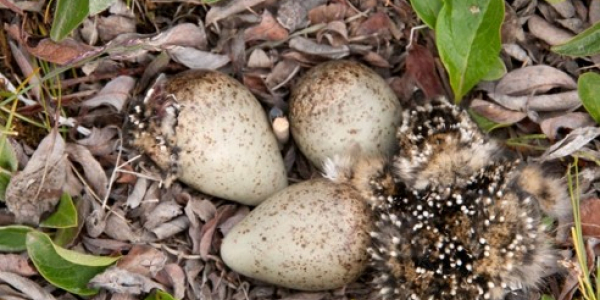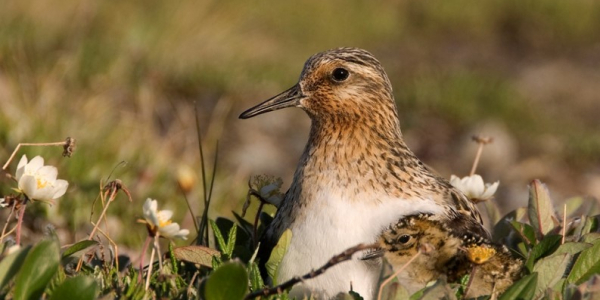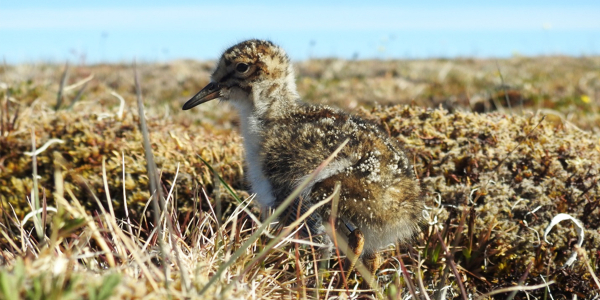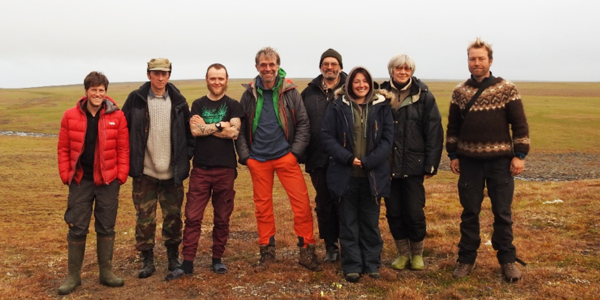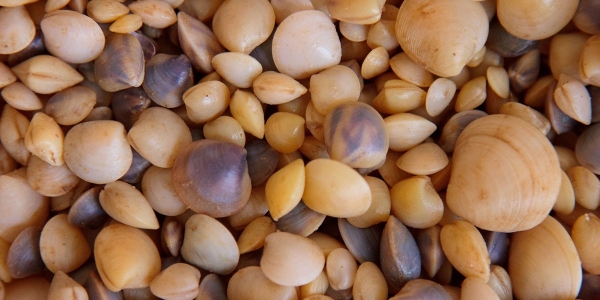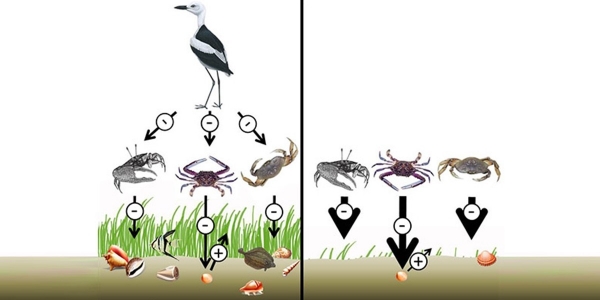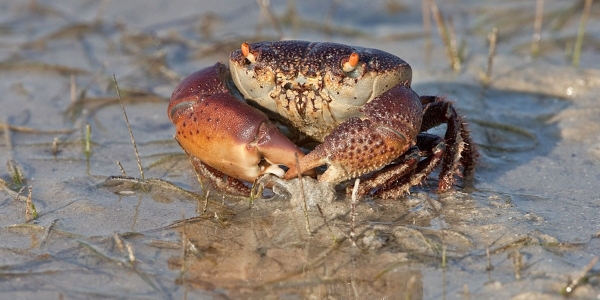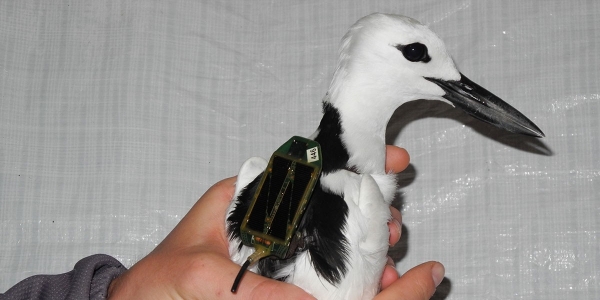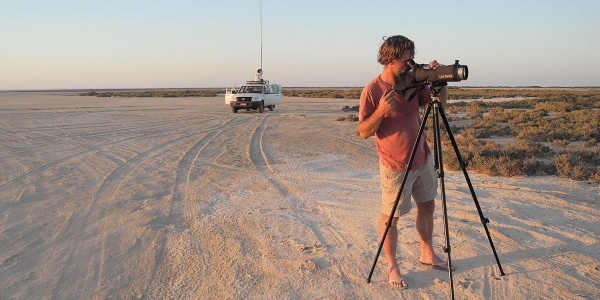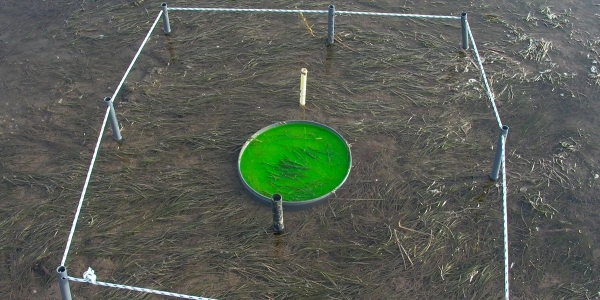Prof. Dr. Jan van Gils
'The red knot is the canary in our global coal mine'
Ecologist Jan van Gils investigates the red knot, a wader that breeds in the Arctic, overwinters in the Wadden Sea, but also migrates through the Netherlands to its winter quarters in West Africa. ‘In effect, the red knot is like a canary in a global coal mine. Just like the miner’s canaries in the past warned for impending high concentrations of mine gases, the red knot now informs us now about the state of the climate.’
Evolution in action
‘We can see that over the past 35 years, red knots have gradually become smaller, and we are now investigating whether that might be due to insects in the rapidly warming Siberian breeding grounds emerging from the soil earlier; too early for red knot chicks to grow to full adult body size. In the overwintering area in West Africa, it is precisely the smaller red knots that tend to perish first, because their beaks have become too short to reach the food. The birds with the highest chance of survival are those that still have a relatively long beak despite the shrinking. So here we see evolution in action: red knots are becoming smaller with relatively longer beaks.’
‘Red knots are not only shrinking; a shift in their sex ratio is occurring too. Male birds are increasingly often in the minority, and that is already the case when they hatch from the egg. That also seems to be a consequence of the shifting temperature and the lower survival chances of the males, which are slightly smaller than the females.'
Red knots are the link
'All things being considered, we study far more than just the one species of wader, however interesting that one species is. The red knot connects the far north with our Wadden Sea, with Africa, and ultimately with our entire planet. What we do with greenhouse gases in the atmosphere has a relatively strong effect on the Arctic region and with that eventually on the survival of birds in West Africa. The fact that the red knot is shrinking is a foreboding sign. Research into fossils reveals that animals that became extinct often experienced a period of shrinking first.’
Read more +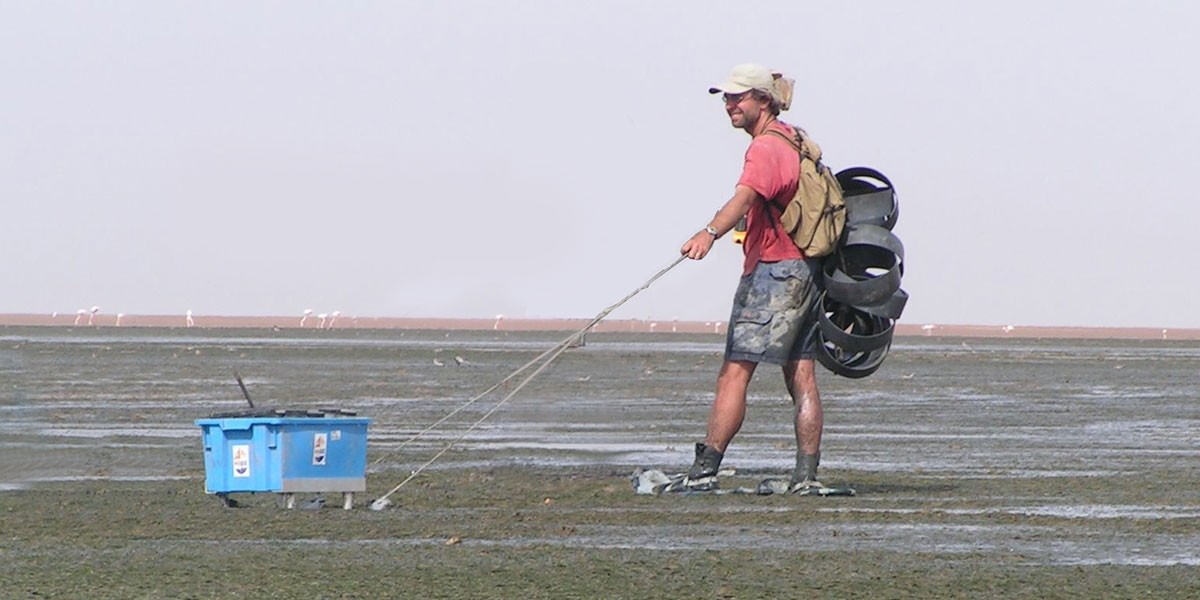
Research interests
In the current biodiversity decline, predators are often the first to disappear. Predators are thought to play a positive role in biodiversity maintenance as they prevent certain prey species in achieving dominance, relaxing resource competition among prey, hence promoting prey growth rates, prey coexistence and diversity. Losses of species at the highest trophic levels in communities may therefore cause extinctions and shifts in size structure at lower trophic levels. However, this role of predators is still often underappreciated, largely because many ecosystems have already lost their top-predators and/or human-induced disturbances now blur the positive predation effects. Most of all, the role of migrant predators structuring communities along their migratory route has mostly been neglected.
Aiming to fill this knowledge gap, we study the role of molluscivore shorebirds for intertidal benthic communities, with a focus on the pristine and uninhabited Banc d’Arguin (Mauritania). On their way to and from Mauritania, these shorebirds (re)fuel in the Dutch Wadden Sea, an area that has lost much of its value due to human disturbance (notably bottom-disturbing fisheries). Therefore, molluscivore shorebird numbers are on the decline, both in the Wadden Sea and in West-Africa, and we are investigating whether the benthic community changes observed at Banc d’Arguin may in fact represent ‘spatial knock-on effects’ of human disturbance in the Wadden Sea. Recently, in parallel with the project in Mauritania, a project on crustacean-eating crab plovers in Barr al Hikman (Oman) has started.
Functions
From 2020: Honorary Professor, Global Change Ecology of Migrant Shorebirds, University of Groningen
2015-2019: Lecturer, MSc programme Marine Biology, University of Groningen (ad honorem)
From 2014: Senior Scientist at NIOZ
2010-2014: Tenure Tracker at NIOZ (NWO-VIDI grant)
2006-2010: Postdoc at NIOZ (NWO-WOTRO grant)
2006-2007: Postdoc at Bristol University, UK (NWO-TALENT grant)
2003-2008: Postdoc at NIOO (KNAW-Vernieuwingsfonds)
1997-2004: PhD-student at NIOZ/University of Groningen (NWO-PIONIER grant)
Key-publications
Rakhiemberdiev, E., Duijns, S., Karagicheva, J., Camphuysen, C. J., VRS Castricum, Dekinga, A., Dekker, R., Gavrilov, A., ten Horn, J., Jukema, J., Saveliev, A., Soloviev, M., Tibbitts, T.L., van Gils, J.A. & T. Piersma (2018). Fuelling conditions at staging sites can mitigate Arctic warming effects in a migratory bird. Nature Commun. 9, 4263.
van Gils, J.A., Lisovski, S., Lok, T., Meissner, W., Ożarowska, A., de Fouw, J., Rakhimberdiev, E., Soloviev, M.Y., Piersma, T. & M. Klaassen (2016). Body shrinkage due to Arctic warming reduces red knot fitness in tropical wintering range. Science 352, 819-821.
van Gils, J.A., van der Geest, M., Leyrer, J., Oudman, T., Lok, T., Onrust, J., de Fouw, J., van der Heide, T., van den Hout, P.J., Spaans, B., Dekinga, A., Brugge, M. & T. Piersma (2013). Toxin constraint explains diet choice, survival and population dynamics in a molluscivore shorebird. Proc. R. Soc. B 280, 20130861.
van der Heide, T., Govers, L.L., de Fouw, J., Olff, H., van der Geest, M., van Katwijk, M.M., Piersma, T., van de Koppel, J., Silliman, B.R., Smolders, A.J.P. & J.A. van Gils (2012). A three-stage symbiosis forms the foundation of seagrass ecosystems. Science 336, 1432-1434.
Piersma, T. & J.A. van Gils (2011). The Flexible Phenotype: A Body-Centred Integration of Ecology, Physiology, and Behaviour. Oxford University Press, Oxford. 238 p.
Professional education
2004: PhD Mathematics and Natural Sciences, University of Groningen (cum laude)
1996: MSc Biology, University of Groningen (cum laude)
1990: BSc Biology, University of Groningen (cum laude)
1989: Athenaeum B, Theresialyceum, Tilburg
Awards and Prizes
2019: Vici Grant, NWO (1,5 M€)
2018: ALW Open Competition, NWO
2017: Netherlands Polar Programme Grant, NWO
2015: MARES Grant (Erasmus Mundus, EU)
2013: Research Project Grant, TRC (Oman)
2011: ALW Open Competition, NWO
2009: Vidi Grant, NWO
2007: Dutch Zoology Prize, Royal Dutch Zoological Society
2006: WOTRO Integrated Programme, NWO
2005: Rubicon Grant, NWO
2004: Best PhD Thesis in Functional Ecology Graduate School
Remote sensing and geospatial data analysis of Barr al Hikman intertidal ecosystem (TRC grant, Oman)
Fragile biodiversity linkages: production and consumption in a nutrient-poor seagrass-dominated intertidal ecosystem, the Banc d’Arguin, Mauritania (NWO-WOTRO grant)
Linked news
Linked blogs
NIOZ publications
-
2024
Versluijs, T.S.L.; Zhemchuzhnikov, M.K.; Kutcherov, D.; Roslin, T.; Schmidt, N.M.; van Gils, J.A.; Reneerkens, J. (2024). Different currencies for calculating resource phenology result in opposite inferences about trophic mismatches. Proc. - Royal Soc., Biol. Sci. 291(2019): 20231785. https://dx.doi.org/10.1098/rspb.2023.1785Zhemchuzhnikov, M.K.; Lameris, T.K.; Soloviev, M.Y.; Golovnyuk, V.V.; ten Horn, J.; Kutcherov, D.; Popovkina, A.B.; Sukhova, M.A.; Zhemchuzhnikova, E.A.; van Gils, J.A. (2024). Food web interactions of two breeding Arctic shorebird species, little stint Calidris minuta and red knot Calidris canutus, are shaped by their elevational distribution. Polar Biol. 47(3): 247-261. https://dx.doi.org/10.1007/s00300-024-03227-yZhemchuzhnikov, M.K.; Zhemchuzhnikova, E.A.; Lameris, T.K.; van Bleijswijk, J.D.L.; Golovnyuk, V.V.; ten Horn, J.; Kutcherov, D.; Popovkina, A.B.; Soloviev, M.Y.; Sukhova, M.A.; Witte, H.J.; van Gils, J.A. (2024). Disentangling the diet composition of chicks of Arctic shorebirds provides a new perspective on trophic mismatches. Food Webs 39: e00349. https://dx.doi.org/10.1016/j.fooweb.2024.e00349
-
2023
El-Hacen, E. M.; Lemrabott, S.Y.C.; Meijer, K.J.; Piersma, T.; Govers, L.L.; van Gils, J.A.; Olff, H. (2023). Growth and population structure of bloody cockles Senilia senilis at Banc d’Arguin and Bijagós with different environmental conditions and harvesting regimes. Mar. Ecol. Prog. Ser. 710: 71-83. https://dx.doi.org/10.3354/meps14291El-Hacen, E.M.; Lemrabott, S.Y.C.; Meijer, K.J.; Piersma, T.; Govers, L.L.; van Gils, J.A.; Olff, H. (2023). Growth and population structure of bloody cockles Senilia senilis at Banc d’Arguin and Bijagós with different environmental conditions and harvesting regimes. Mar. Ecol. Prog. Ser. 710: 71-83. https://dx.doi.org/10.3354/meps14291Oortwijn, T.; de Monte, L.; Varley, D.P.; van der Meer, M.T.J.; van Gils, J.A. (2023). Tissue‐ and diet‐dependent stable carbon and nitrogen isotope discrimination: a calibration study in a captive shorebird species. J. Avian Biol. 2023(9-10): e03094. https://dx.doi.org/10.1111/jav.03094Peng, H.-B.; Ma, Z.; Rakhimberdiev, E.; van Gils, J.A.; Battley, P.F.; Rogers, D.I.; Choi, C.-Y.; Wu, W.; Feng, X.; Ma, Q.; Hua, N.; Minton, C.; Hassell, C.J.; Piersma, T. (2023). Arriving late and lean at a stopover site is selected against in a declining migratory bird population. J. Anim. Ecol. 92(10): 2109-2118. https://dx.doi.org/10.1111/1365-2656.14001Piersma, T.; Koolhaas, A.; van Gils, J.A.; Dekinga, A. (2023). Cause for caution: Response to Forum Contribution by van der Meer and Folmer. J. Appl. Ecol. 60(11): 2494-2496. https://dx.doi.org/10.1111/1365-2664.14500Versluijs, T.S.L.; Zhemchuzhnikov, M.K.; Kutcherov, D.; Roslin, T.; Martin Schmidt, N.; van Gils, J.A.; Reneerkens, J. (2023). Site-specific length-biomass relationships of arctic arthropod families are critical for accurate ecological inferences. PeerJ 11: e15943. https://dx.doi.org/10.7717/peerj.15943
-
2022
Lameris, T.K.; Tomkovich, P.S.; Johnson, J.A.; Morisson, R.I.G.; Tulp, I.; Lisovski, S.; DeCicco, L.; Dementyev, M.; Gill, R.E.; ten Horn, J.; Piersma, T.; Pohlen, Z.; Schekkerman, H.; Soloviev, M.; Syroechkovsky, E.E.; Zhemchuzhnikov, M.K.; van Gils, J.A. (2022). Mismatch‐induced growth reductions in a clade of Arctic‐breeding shorebirds are rarely mitigated by increasing temperatures. Glob. Chang. Biol. 28(3): 829-847. https://dx.doi.org/10.1111/gcb.16025Oortwijn, T.; de Fouw, J; Petersen, J.M.; van Gils, J.A. (2022). Sulfur in lucinid bivalves inhibits intake rates of a molluscivore shorebird. Oecologia 199: 69-78. https://dx.doi.org/10.1007/s00442-022-05170-3
-
2021
Aarts, G.M; Mul, E.; Fieberg, J.; Brasseur, S.; van Gils, J.A.; Matthiopoulos, J.; Riotte-Lambert, L. (2021). Individual-level memory is sufficient to create spatial segregation among neighboring colonies of central-place foragers. American Naturalist 198(2): E37-E52. https://doi.org/10.1086/715014Lameris, T.K.; Hoekendijk, J.; Aarts, G.; Aarts, A.; Allen, A.M.; Bienfait, L.; Bijleveld, A.I.; Bongers, M.F.; Brasseur, S.; Chan, Y.-C.; de Ferrante, F.; de Gelder, J.; Derksen, H.; Dijkgraaf, L.; Dijkhuis, L.R.; Dijkstra, S.; Elbertsen, G.; Ernsten, R.; Foxen, T.; Gaarenstroom, J.; Gelhausen, A.; van Gils, J.A.; Grosscurt, S.; Grundlehner, A.; Hertlein, M.L.; van Heumen, A.J.P.; Heurman, M.; Huffeldt, N.P.; Hutter, W.H.; Kamstra, Y.J.J.; Keij, F.; van Kempen, S.; Keurntjes, G.; Knap, H.; Loonstra, A.H.J.; Nolet, B.A.; Nuijten, R.J.M.; Mattijssen, D.; Oosterhoff, H.; Paarlberg, N.; Parekh, M.; Pattyn, J.; Polak, C.; Quist, Y.; Ras, S.; Reneerkens, J.; Ruth, S.; van der Schaar, E.; Schroen, G.; Spikman, F.; van Velzen, J.; Voorn, E.; Vos, J.; Wang, D.; Westdijk, W.; Wind, M.; Zhemchuzhnikov, M.K.; van Langevelde, F. (2021). Migratory vertebrates shift migration timing and distributions in a warming Arctic. Animal Migration 8(1): 110-131. https://dx.doi.org/10.1515/ami-2020-0112Osvatic, J.T.; Wilkins, L.G.E.; Leibrecht, L.; Leray, M.; Zauner, S.; Polzin, J.; Camacho, Y.; Gros, O.; van Gils, J.A.; Eisen, J.A.; Petersen, J.M.; Yuen, B. (2021). Global biogeography of chemosynthetic symbionts reveals both localized and globally distributed symbiont groups. Proc. Natl. Acad. Sci. U.S.A. 118(29): e2104378118. https://dx.doi.org/10.1073/pnas.2104378118Zhemchuzhnikov, M.K.; Versluijs, T.S.L.; Lameris, T.K.; Reneerkens, J.; Both, C.; van Gils, J.A. (2021). Exploring the drivers of variation in trophic mismatches: A systematic review of long‐term avian studies. Ecol. Evol. 11(9): 3710-3725. https://doi.org/10.1002/ece3.7346
-
2020
Bom, R.A.; van Gils, J.A.; Molenaar, K.; Kwarteng, A.Y.; Victor, R.; Folmer, E.O. (2020). The intertidal mudflats of Barr Al Hikman, Sultanate of Oman, as feeding, reproduction and nursery grounds for brachyuran crabs. Hydrobiologia 847: 4295-4309. https://dx.doi.org/10.1007/s10750-020-04418-4de Fouw, J.; van der Zee, E.M.; van Gils, J.A.; Eriksson, B.K.; Weerman, E.; Donadi, S.; van der Veer, H.W.; Olff, H.; Piersma, T.; van der Heide, T. (2020). The interactive role of predation, competition and habitat conditions in structuring an intertidal bivalve population. J. Exp. Mar. Biol. Ecol. 523: 151267. https://dx.doi.org/10.1016/j.jembe.2019.151267
-
2019
Bulla, M.; Reneerkens, J.; Weiser, E.L.; Sokolov, A.; Taylor, A.R.; Sittler, B.; McCaffery, B.J.; Ruthrauff, D.R.; Catlin, D.H.; Payer, D.C.; Ward, D.H.; Solovyeva, D.V.; Santos, E.S.A.; Rakhimberdiev, E.; Nol, E.; Kwon, E.; Brown, G.S.; Gates, H.R.; Johnson, J.A.; van Gils, J.A.; Hansen, J.; Lamarre, J.-F.; Rausch, J.; Conklin, J.R.; Liebezeit, J.; Bêty, J.; Lang, J.; Alves, J.A.; Fernández-Elipe, J.; Exo, K.-M.; Bollache, L.; Bertellotti, M.; Giroux, M.-A.; van de Pol, M.; Johnson, M.; Boldenow, M.L.; Valcu, M.; Soloviev, M.Y.; Sokolova, N.; Senner, N.R.; Lecomte, N.; Meyer, N.; Schmidt, N.M.; Gilg, G.; Smith, P.A.; Machín, P.; McGuire, R.L.; Cerboncini, R.A.S.; Ottvall, R.; van Bemmelen, R.S.A.; Swift, R.J.; Saalfeld, S.T.; Jamieson, S.E.; Brown, S.; Piersma, T.; Albrecht, T.; D’Amico, V.; Lanctot, R.B.; Kempenaers, B. (2019). Comment on “Global pattern of nest predation is disrupted by climate change in shorebirds”. Science (Wash.) 364(6445): eaaw8529. https://dx.doi.org/10.1126/science.aaw8529van der Geest, M.; van der Lely, J.A.C.; van Gils, J.A.; Piersma, T.; Lok, T. (2019). Density-dependent growth of bivalves dominating the intertidal zone of Banc d’Arguin, Mauritania: importance of feeding mode, habitat and season. Mar. Ecol. Prog. Ser. 610: 51-63. https://doi.org/10.3354/meps12851Zhang, S.-D; Ma, Z.; Choi, C.-Y.; Peng, H.-B.; Melville, D.S.; Zhao, T.-T.; Bai, Q.-Q.; Liu, W.-L.; Chan, Y.-C; van Gils, J.A.; Piersma, T. (2019). Morphological and digestive adjustments buffer performance: how staging shorebirds cope with severe food declines. Ecol. Evol. 9(7): 3868-3878. https://dx.doi.org/10.1002/ece3.5013Zhang, S.-D; Ma, Z.; Feng, C.-C.; Melville, D.S.; van Gils, J.A.; Piersma, T. (2019). Individual diet differences in a molluscivore shorebird are associated with the size of body instruments for internal processing rather than for feeding. J. Avian Biol. 50(10). https://dx.doi.org/10.1111/jav.02255
-
2018
Bom, R.A.; de Fouw, J; Klaassen, R.H.G.; Piersma, T.; Lavaleye, M.S.S.; Ens, B.J.; Oudman, T.; van Gils, J.A. (2018). Food web consequences of an evolutionary arms race: Molluscs subject to crab predation on intertidal mudflats in Oman are unavailable to shorebirds. J. Biogeogr. 45(2): 342-354. https://dx.doi.org/10.1111/jbi.13123Bom, R.A.; van Gils, J.A.; Oosterbeek, K.; Deuzeman, S.; de Fouw, J; Kwarteng, A.Y.; Kentie, R. (2018). Demography of a stable population of crab plovers wintering in Oman. J. Ornithol. 159(2): 517-525. https://dx.doi.org/10.1007/s10336-018-1529-0de Fouw, J; van der Heide, T.; van Belzen, J.; Govers, L.; Cheikh, M.A.S.; Olff, H.; van de Koppel, J.; van Gils, J.A. (2018). A facultative mutualistic feedback enhances the stability of tropical intertidal seagrass beds. NPG Scientific Reports 8(1): 10. https://doi.org/10.1038/s41598-018-31060-xGommer, R.; Bom, R.A.; Fijen, T.P.M.; van Gils, J.A. (2018). Stomach fullness shapes prey choice decisions in crab plovers (Dromas ardeola). PLoS One 13(4): e0194824. https://dx.doi.org/10.1371/journal.pone.0194824Oudman, T.; Piersma, T.; Ahmedou Salem, M.V.; Feis, M.E.; Dekinga, A.; Holthuijsen, S.; ten Horn, J.; van Gils, J.A.; Bijleveld, A.I. (2018). Resource landscapes explain contrasting patterns of aggregation and site fidelity by red knots at two wintering sites. Movement Ecology 6(24). https://doi.org/10.1186/s40462-018-0142-4Rakhimberdiev, E.; Duijns, S.; Karagicheva, J.; Camphuysen, C.J.; VRS Castricum; Dekinga, A.; Dekker, R.; Gavrilov, A.; ten Horn, J.; Jukema, J.; Saveliev, A.; Soloviev, M.Y.; Tibbitts, T.L.; van Gils, J.A.; Piersma, T. (2018). Fuelling conditions at staging sites can mitigate Arctic warming effects in a migratory bird. Nature Comm. 9: 4263. https://dx.doi.org/10.1038/s41467-018-06673-5Zhang, S.-D.; Ma, Z.; Choi, C.-Y.; Peng, H.-B.; Bai, Q.-Q.; Liu, W.-L.; Tan, K.; Melville, D.S.; He, P.; Chan, Y.-C; van Gils, J.A.; Piersma, T. (2018). Persistent use of a shorebird staging site in the Yellow Sea despite severe declines in food resources implies a lack of alternatives. Bird. Cons. Intern. 28(4): 534-548. https://doi.org/10.1017/S0959270917000430
-
2017
Kronfeld-Schor, N.; Visser, M.E.; Salis, L.; van Gils, J.A. (2017). Chronobiology of interspecific interactions in a changing world. Phil. Trans. R. Soc. Lond. (B Biol. Sci.) 372(1734): 20160248. https://dx.doi.org/10.1098/rstb.2016.0248
-
2016
Bijleveld, A.I.; MacCurdy, R.B.; Chan, Y.-C; Penning, E.; Gabrielson, R.M.; Cluderay, J.; Spaulding, E.L.; Dekinga, A.; Holthuijsen, S.; Ten Horn, J.; Brugge, M.; van Gils, J.A.; Winkler, D.W.; Piersma, T. (2016). Understanding spatial distributions: negative density-dependence in prey causes predators to trade-off prey quantity with quality. Proc. - Royal Soc., Biol. Sci. 283: 1828. https://dx.doi.org/10.1098/rspb.2015.1557Compton, T.J.; Bodnar, W.; Koolhaas, A.; Dekinga, A.; Holthuijsen, S.; Ten Horn, J.; McSweeney, N.; van Gils, J.A.; Piersma, T. (2016). Burrowing Behavior of a Deposit Feeding Bivalve Predicts Change in Intertidal Ecosystem State. Front. Ecol. Evol. 4: 19. https://dx.doi.org/10.3389/fevo.2016.00019de Fouw, J.; Govers, L.; van de Koppel, J.; van Belzen, J.; Dorigo, W.; Sidi Cheikh, M.A.; Christianen, M.J.A.; van der Reijden, K.J.; van der Geest, M.; Piersma, T.; Smolders, A.J.P.; Olff, H.; Lamers, L.P.M.; van Gils, J.A.; van der Heide, T. (2016). Drought, mutualism breakdown, and landscape-scale degradation of seagrass beds. Curr. Biol. 26(8): 1051-1056. https://dx.doi.org/10.1016/j.cub.2016.02.023de Fouw, J.; van der Heide, T.; Oudman, T.; Maas, L.R.M.; Piersma, T.; van Gils, J.A. (2016). Structurally complex sea grass obstructs the sixth sense of a specialized avian molluscivore. Anim. Behav. 115: 55-67. dx.doi.org/10.1016/j.anbehav.2016.02.017Hoye, B.J.; Munster, V.J.; Huig, N.; de Vries, P.; Oosterbeek, K.; Tijssen, W.; Klaassen, M.; Fouchier, R.A.M.; van Gils, J.A. (2016). Hampered performance of migratory swans: intra- and interseasonal effects of avian influenza virus. Integrative and Comparative Biology 56(3): 1-13. dx.doi.org/10.1093/icb/icw038Oudman, T.; Bijleveld, A.I.; Kavelaars, M.M.; Dekinga, A.; Cluderay, J.; Piersma, T.; van Gils, J.A. (2016). Diet preferences as the cause of individual differences rather than the consequence. J. Anim. Ecol. 85(5): 1378-1388. https://dx.doi.org/10.1111/1365-2656.12549Van der Zee, E.M.; Angelini, C.; Govers, L.; Christianen, M.J.A.; Altieri, A.H.; van der Reijden, K.J.; Silliman, B.R.; van de Koppel, J.; van der Geest, M.; van Gils, J.A.; van der Veer, H.W.; Piersma, T.; de Ruiter, P.C.; Olff, H.; van der Heide, T. (2016). How habitat-modifying organisms structure the food web of two coastal ecosystems. Proc. - Royal Soc., Biol. Sci. 283(1826): 20152326. https://dx.doi.org/10.1098/rspb.2015.2326van Gils, J.A.; Lisovski, S.; Lok, T.; Meissner, W.; Ozarowska, A.; de Fouw, J.; Rakhimberdiev, E.; Soloviev, M.Y.; Piersma, T.; Klaassen, M. (2016). Body shrinkage due to Arctic warming reduces red knot fitness in tropical wintering range. Science (Wash.) 352(6287): 819-821. https://dx.doi.org/10.1126/science.aad6351
-
2015
Bijleveld, A.I.; Twietmeyer, S.; Piechocki, J.; van Gils, J.A.; Piersma, T. (2015). Natural selection by pulsed predation: survival of the thickest. Ecology 96(7): 1943-1956. dx.doi.org/10.1890/14-1845.1Bijleveld, A.I.; van Gils, J.A.; Jouta, J.; Piersma, T. (2015). Benefits of foraging in small groups: An experimental study on public information use in red knots Calidris canutus. Behav. Process. 117: 74-81. dx.doi.org/10.1016/j.beproc.2014.09.003Duijns, S.; Knot, I.E.; Piersma, T.; van Gils, J.A. (2015). Field measurements give biased estimates of functional response parameters, but help explain foraging distributions. J. Anim. Ecol. 84(2): 565–575. dx.doi.org/10.1111/1365-2656.12309Duijns, S.; van Gils, J.A.; Smart, J.; Piersma, T. (2015). Phenotype-limited distributions: short-billed birds move away during times that prey bury deeply. Royal Society Open Science 2: 1-11. dx.doi.org/10.1098/rsos.150073Oudman, T.; Hin, V.; Dekinga, A.; van Gils, J. (2015). The Effect of Digestive Capacity on the Intake Rate of Toxic and Non-Toxic Prey in an Ecological Context. PLoS One 10(8): e0136144. dx.doi.org/10.1371/journal.pone.0136144Ruthrauff, D.R.; Dekinga, A.; Gill, R.E.; van Gils, J.A.; Piersma, T. (2015). Ways to be different: foraging adaptations that facilitate higher intake rates in a northerly wintering shorebird compared with a low-latitude conspecific. J. Exp. Biol. 218: 1188-1197. dx.doi.org/10.1242/jeb.108894van Gils, J.A.; Ahmedou Salem, M.V. (2015). Validating the Incorporation of 13C and 15N in a Shorebird That Consumes an Isotopically Distinct Chemosymbiotic Bivalve. PLoS One 10(10): e0140221. dx.doi.org/10.1371/journal.pone.0140221van Gils, J.A.; van der Geest, M.; De Meulenaer, B.; Gillis, H.; Piersma, T.; Folmer, E.O. (2015). Moving on with foraging theory: incorporating movement decisions into the functional response of a gregarious shorebird. J. Anim. Ecol. 84(2): 554–564. dx.doi.org/10.1111/1365-2656.12301
-
2014
Ahmedou Salem, M.V.; van der Geest, M.; Piersma, T.; Saoud, Y.; van Gils, J.A. (2014). Seasonal changes in mollusc abundance in a tropical intertidal ecosystem, Banc d'Arguin (Mauritania): Testing the 'depletion by shorebirds' hypothesis. Est., Coast. and Shelf Sci. 136: 26-34. dx.doi.org/10.1016/j.ecss.2013.11.009Bijleveld, A.I.; Massourakis, G.; van der Marel, A.; Dekinga, A.; Spaans, B.; van Gils, J.A.; Piersma, T. (2014). Personality drives physiological adjustments and is not related to survival. Proc. - Royal Soc., Biol. Sci. 281: 20133135. dx.doi.org/10.1098/rspb.2013.3135Bom, R.A.; Bouten, W.; Piersma, T.; Oosterbeek, K.; van Gils, J.A. (2014). Optimizing acceleration-based ethograms: the use of variable-time versus fixed-time segmentation. Movement Ecology 2(6): 1-8. hdl.handle.net/10.1186/2051-3933-2-6Duijns, S.; van Gils, J.A.; Spaans, B.; ten Horn, J.; Brugge, M.; Piersma, T. (2014). Sex-specific winter distribution in a sexually dimorphic shorebird is explained by resource partitioning. Ecol. Evol. 4(20): 4009–4018. dx.doi.org/10.1002/ece3.1213Oudman, T.; Onrust, J.; de Fouw, J.; Spaans, B.; Piersma, T.; van Gils, J.A. (2014). Digestive Capacity and Toxicity Cause Mixed Diets in Red Knots That Maximize Energy Intake Rate. American Naturalist 183(5): 650-659. dx.doi.org/10.1086/675759Piersma, T.; MacCurdy, R.B.; Gabrielson,, R.M.; Dekinga, A.; Cluderay, J.; Spaulding, E.L.; Oudman, T.; van Gils, J.; Winkler, D.; Bijleveld, A. (2014). Fijnmazige positiebepaling van individuen in groepen : de principes en drie toepassingen van TOA-tracking. Limosa (Amst.) 87: 156-176van den Hout, P.J.; van Gils, J.A.; Robin, F.; van der Geest, M.; Dekinga, A.; Piersma, T. (2014). Interference from adults forces young red knots to forage for longer and in dangerous places. Anim. Behav. 88: 137-146. dx.doi.org/10.1016/j.anbehav.2013.11.020van der Geest, M.; Sall, A.A.; Ely, S.O.; Nauta, R.W.; van Gils, J.A.; Piersma, T. (2014). Nutritional and reproductive strategies in a chemosymbiotic bivalve living in a tropical intertidal seagrass bed. Mar. Ecol. Prog. Ser. 501: 113-126. dx.doi.org/10.3354/meps10702
-
2013
Onrust, J.; de Fouw, J.; Oudman, T.; van der Geest, M.; Piersma, T.; van Gils, J.A. (2013). Red Knot diet reconstruction revisited: context dependence revealed by experiments at Banc d'Arguin, Mauritania. Bird Study 60(3): 298-307. hdl.handle.net/10.1080/00063657.2013.811213van Gils, J.A.; van der Geest, M.; Leyrer, J.; Oudman, T.; Lok, T.; Onrust, J.; de Fouw, J.; van der Heide, T.; van den Hout, P.J.; Spaans, B.; Dekinga, A.; Brugge, M.; Piersma, T. (2013). Toxin constraint explains diet choice, survival and population dynamics in a molluscivore shorebird. Proc. - Royal Soc., Biol. Sci. 280(1763). dx.doi.org/10.1098/rspb.2013.0861Yang, H.-Y.; Ma, Z.-J.; Hua, N.; van Gils, J.A.; Zhang, Z.-W.; Piersma, T. (2013). Economic design in a long-distance migrating molluscivore: how fast-fuelling red knots in Bohai Bay, China, get away with small gizzards. J. Exp. Biol. 216(19): 3627-3636. dx.doi.org/10.1242/jeb.083576
-
2012
Bijleveld, A.I.; van Gils, J.A.; van der Meer, J.; Dekinga, A.; Kraan, C.; van der Veer, H.W.; Piersma, T. (2012). Designing a benthic monitoring programme with multiple conflicting objectives. Methods Ecol. Evol. 3(3): 526-536. dx.doi.org/10.1111/j.2041-210X.2012.00192.xFolmer, E.O.; van der Geest, M.; Jansen, E.; Olff, H.; Anderson, T.M.; Piersma, T.; van Gils, J.A. (2012). Seagrass-Sediment Feedback: An Exploration Using a Non-recursive Structural Equation Model. Ecosystems 15(8): 1380-1393. dx.doi.org/10.1007/s10021-012-9591-6Leyrer, J.; Lok, T.; Brugge, M.; Dekinga, A.; van Gils, J.A.; Sandercock, B.K.; Piersma, T. (2012). Small-scale demographic structure suggests preemptive behavior in a flocking shorebird. Behav. Ecol. 23(6): 1226-1233. dx.doi.org/10.1093/beheco/ars106van der Heide, T.; Govers, L.L.; de Fouw, J.; Olff, H.; van der Geest, M.; van Katwijk, M.M.; Piersma, T.; van de Koppel, J.; Silliman, B.R.; Smolders, A.J.P.; van Gils, J.A. (2012). A three-stage symbiosis forms the foundation of seagrass ecosystems. Science (Wash.) 336(6087): 1432-1434. dx.doi.org/10.1126/science.1219973van Gils, J.A.; van der Geest, M.; Jansen, E.J.; Govers, L.L.; de Fouw, J.; Piersma, T. (2012). Trophic cascade induced by molluscivore predator alters pore-water biogeochemistry via competitive release of prey. Ecology 93(5): 1143-1152. dx.doi.org/10.1890/11-1282.1
-
2011
Acou, A.; Rivot, E.; van Gils, J.A.; Legault, A.; Ysnel, F.; Feunteun, E. (2011). Habitat carrying capacity is reached for the European eel in a small coastal catchment: evidence and implications for managing eel stocks. Freshwat. Biol. 56(5): 952-968. dx.doi.org/10.1111/j.1365-2427.2010.02540.xPiersma, T.; van Gils, J.A. (2011). The Flexible Phenotype: a body-centred integration of ecology, physiology and behaviour. Oxford University Press: Oxford. ISBN 9780199233724. 1-248 pp.Quaintenne, G.; van Gils, J.A.; Bocher, P.; Dekinga, A.; Piersma, T. (2011). Scaling up ideals to freedom: are densities of red knots across western Europe consistent with ideal free distribution? Proc. - Royal Soc., Biol. Sci. 278(1719): 2728-2736. dx.doi.org/10.1098/rspb.2011.0026van der Geest, M.; van Gils, J.A.; van der Meer, J.; Olff, H.; Piersma, T.; van der Meer, J.; Piersma, T. (2011). Suitability of calcein as an in situ growth marker in burrowing bivalves. J. Exp. Mar. Biol. Ecol. 399(1): 1-7. dx.doi.org/10.1016/j.jembe.2011.01.003
